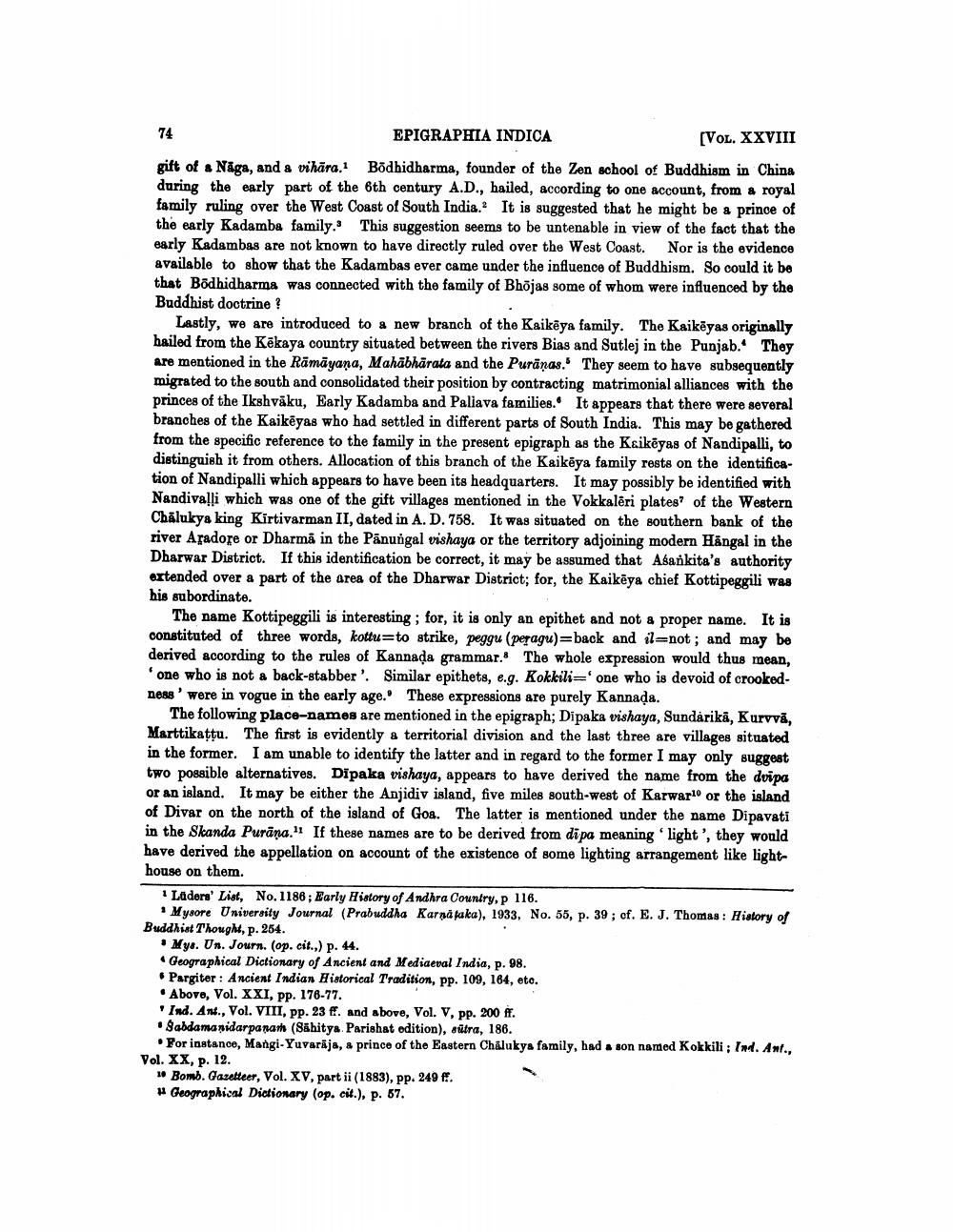________________
74 EPIGRAPHIA INDICA
(VOL. XXVIII gift of & Näga, and a vihāra. Bödhidharma, founder of the Zen school of Buddhism in China during the early part of the 6th century A.D., hailed, according to one account, from a royal family ruling over the West Coast of South India. It is suggested that he might be a prince of the early Kadamba family. This suggestion seems to be untenable in view of the fact that the early Kadambas are not known to have directly ruled over the West Coast. Nor is the evidence available to show that the Kadambas ever came under the influence of Buddhism. So could it be that Bödhidharma was connected with the family of Bhõjas some of whom were influenced by the Buddhist doctrine ?
Lastly, we are introduced to a new branch of the Kaikēya family. The Kaikēgas originally hailed from the Kēkaya country situated between the rivers Bias and Sutlej in the Punjab. They Are mentioned in the Rāmāyana, Mahābhārata and the Puranas. They seem to have subsequently migrated to the south and consolidated their position by contracting matrimonial alliances with the princes of the Ikshväku, Early Kadamba and Paliava families. It appears that there were several branches of the Kaikėyas who had settled in different parts of South India. This may be gathered from the specific reference to the family in the present epigraph as the Kaikēgas of Nandipalli, to distinguish it from others. Allocation of this branch of the Kaikėya family rests on the identification of Nandipalli which appears to have been its headquarters. It may possibly be identified with Nandivalli which was one of the gift villages mentioned in the Vokkalēri plates? of the Western Chalukya king Kirtivarman II, dated in A. D. 758. It was situated on the southern bank of the river Aradore or Dharma in the Pānungal vishaya or the territory adjoining modern Hångal in the Dharwar District. If this identification be correct, it may be assumed that Asankita's authority extended over a part of the area of the Dharwar District; for, the Kaikėya chief Kottipeggili was his subordinate.
The name Kottipeggili is interesting; for, it is only an epithet and not a proper name. It is constituted of three words, kottu=to strike, peggu (peragu)=back and il=not; and may be derived according to the rules of Kannada grammar. The whole expression would thus mean,
one who is not a back-stabber'. Similar epithets, e.g. Kokkili= one who is devoid of crookedness' were in vogue in the early age. These expressions are purely Kannada.
The following place-names are mentioned in the epigraph; Dipaka vishaya, Sundarikā, Kurvvă, Marttikattu. The first is evidently a territorial division and the last three are villages situated in the former. I am unable to identify the latter and in regard to the former I may only suggest two possible alternatives. Dipaka vishaya, appears to have derived the name from the dvipa or an island. It may be either the Anjidiv island, five miles south-west of Karwarlo or the island of Divar on the north of the island of Goa. The latter is mentioned under the name Dipavati in the Skanda Purana." If these names are to be derived from dipa meaning light', they would have derived the appellation on account of the existence of some lighting arrangement like lighthouse on them.
Laders' List, No. 1186; Early History of Andhra Country, p 116.
Mysore University Journal (Prabuddha Karnataka), 1933, No. 55, p. 39; of. E. J. Thomas : History of Buddhist Thought, p. 254.
• Mys. Un. Journ. (op. cit., p. 44. • Geographical Dictionary of Ancient and Mediaeval India, p. 98. • Pargiter: Ancient Indian Historical Tradition, pp. 109, 164, eto. • Abovo, Vol. XXI, pp. 176-77.
Ind. An., Vol. VIII, pp. 23 ff. and above, Vol. V, pp. 200 ff. • Sabdamasidarpanan (Sahitya Parishat edition), astra, 186.
. For instance, Mangi-Yuvarāja, & prince of the Eastern Chalukys family, had a son named Kokkili; Ind. Ant., Vol. XX, p. 12.
** Bomb. Gazetteer, Vol. XV, part ii (1883), pp. 249 f. # Geographical Dictionary (op. cit.), p. 67.




